
How to Write a Perfect Essay Outline

You can’t write an essay without outlining. Fine, you can do that if a low grade is okay for you to get. But those willing to craft a paper that’s worth A+ will need to create an essay outline and organize their research in one place before writing. So in this article we will look at outline examples and top tips to improve your essay.
This guide is here to help you:
- understand what is a paper outline,
- learn how to write an essay outline,
- get outline examples and templates to use when crafting yours.
So, let’s a research essay outline journey begin!
Table of Contents:
- What is an essay outline?
- How to write an essay outline
- Essay outline template
- How to make an outline: the process
- It’s a wrap!
What is an Essay Outline?
As you’ve already guessed it, an essay outline is a short plan of your research paper. Here you write down the main idea of your essay and structurize all arguments into paragraphs to make sure you won’t miss anything while writing.
Sure enough, you can write an essay without outlining it. But it will be challenging to do. Outlining is an essential part of the writing process, and all authors do it for their works to impress readers.
Here’s why you need an essay outline:
- It will help you organize thoughts: when you research the data for your essay, you get tons of information that’s hard to remember.
- You’ll understand the information flow and will be able to structurize it accordingly.
- It will help you not to miss anything while writing your essay because you’ll have a ready manuscript of your paper.
That said, an outline will help you write academic works better and faster. And while our writers are always here to help to write my essay, it can’t hurt to learn how to write an outline for an essay by your own, right?
How to Write an Essay Outline
While college essay types are many, the common structure for most of them is five-paragraph. Each essay needs Introduction, Body (paragraphs with arguments), and Conclusion; so, a general format of your essay outline will include all these components.
Outlining your essay, keep write my term paper in mind so you wouldn’t miss any arguments, evidence, and examples while writing.
So, let’s do this!

Key Parts of an Essay
Put them all into your writing outline:
- Introduction. Here you’ll mention the topic of your essay and its thesis. As you know, essays can’t live without a thesis; so, a thesis statement in your outline will help you support it in each paragraph of your essay body.
- Body paragraphs. There will be a minimum three paragraphs in your essay’s body, so make sure to include each one in the outline. For each paragraph, write down a topic sentence with an argument relating to your thesis and mention all the support: data, facts, examples, and other evidence you’ll use to prove the topic sentence of this paragraph.
- Conclusion. Wrap up your essay here. Restate your thesis and summarize the goal of your paper.
In general, your essay template will look like this:
Essay Outline: General
I. Introduction
a) Introduce a topic
b) State a thesis
II. Body. Paragraph-1
a) Write a topic sentence (the argument for your thesis)
b) Support this argument: data, facts, examples
c) Explain how they relate to your thesis
III. Body. Paragraph-2
a) Write a topic sentence (another argument for your thesis)
b) Support this argument: data, facts, examples
c) Explain how they relate to your thesis
IV. Body. Paragraph-3
a) Write a topic sentence (another argument for your thesis, or a counterargument)
b) Support this argument, or explain why the counterargument doesn’t work: data, facts, examples
c) Explain how they relate to your thesis
V. Conclusion
a) Summarize all main points
b) Restate your thesis
c) Add a call to action: what you want readers to do after reading your essay

Outline Format
As a rule, students use the linear style when formatting their writing outline. It means they rank arguments in order of their importance – from major to minor ones.
Remember: your research essay outline doesn’t have to include the complete sentences. It’s only an outline, so feel free to format arguments and evidence the way it seems most comfortable and understandable for you. Just make sure it’s visually clear and allows you to see if some sections are repetitive or redundant. It will help to avoid duplications in your essay maker.
Another point to consider:
While you are familiar with a given essay topic, it doesn’t mean your readers are. So format your outline accordingly: assume that some people know nothing about it when preparing arguments and arranging them in a logical order.
Essay Outline Template
Templates can help you get a better idea of essay outlining. It’s a great way to organize thoughts and determine the order in which you’ll represent them to readers. So, make a list of the sections in your paper and fill in the corresponding example, depending on your essay type.
Persuasive Essay Outline Example
To create an outline for such an essay, consider the following example:
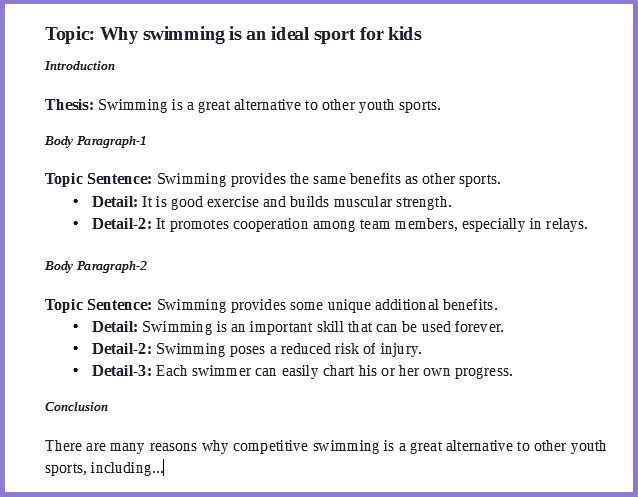
Taken from: TeacherVision.com
Narrative Essay Outline Example
For narrative essays, outlines like this one will work well:
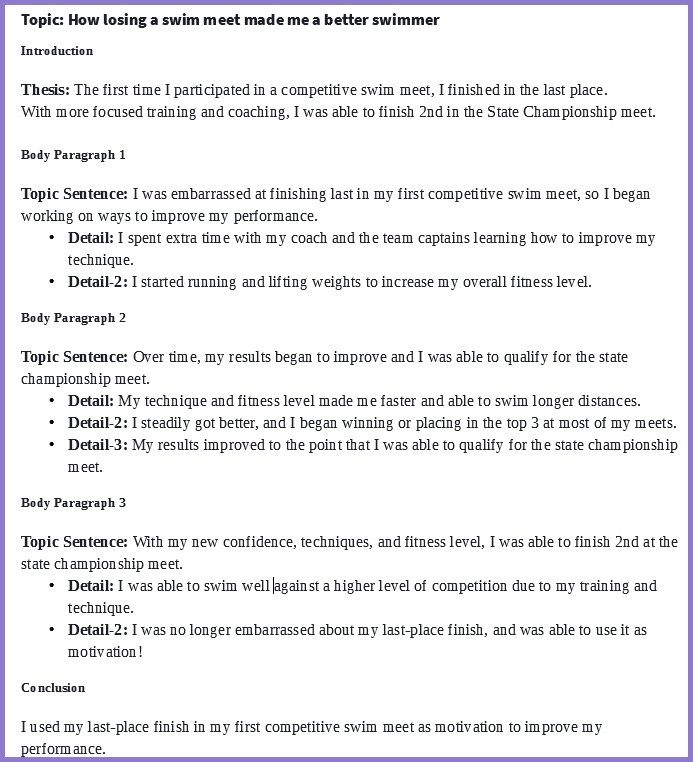
Taken from: TeacherVision.com
Expository Essay Outline Example
What about this example for your essay outline?
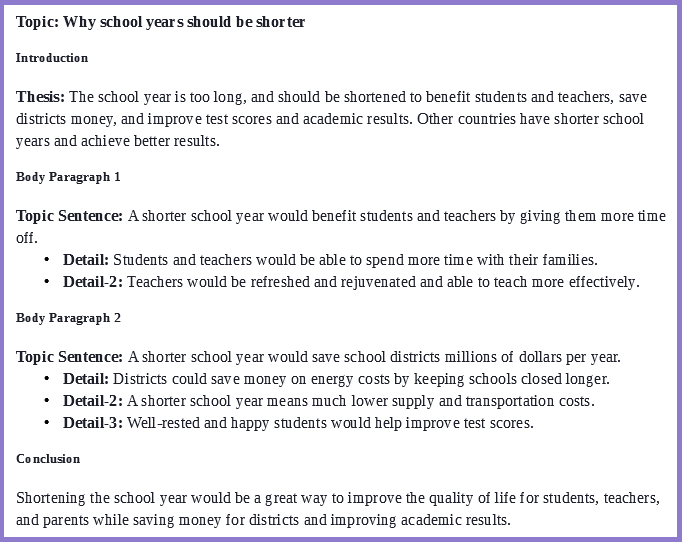
Taken from: TeacherVision.com
Research Essay Outline Example
For a research essay outline, consider this example:
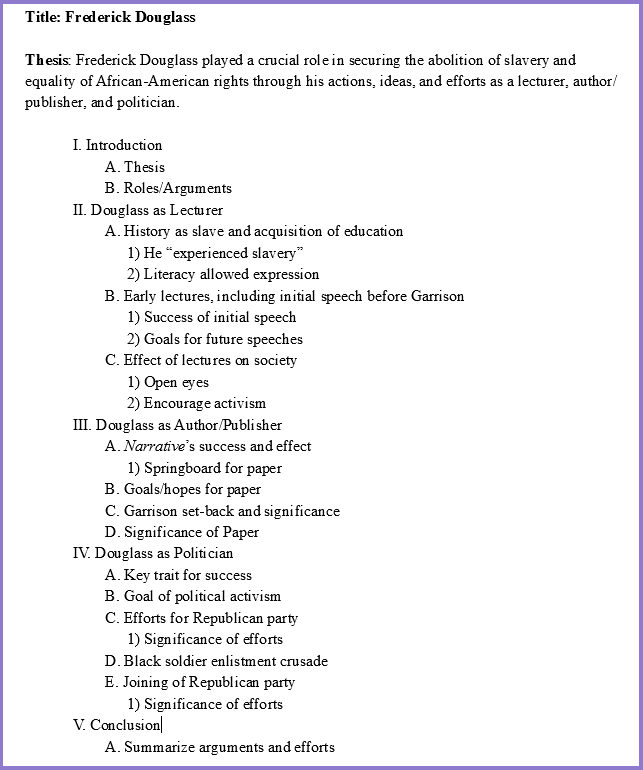
Taken from: Austincc.edu
How to Make an Outline: the Process
As a rule, the only detail bothering those asking how to make an outline for an essay is the process itself. Students understand that an essay outline needs to specify all the main points and arguments of their future paper, but they still find it challenging to create.
More than that, professors may ask you to submit an essay outline for their review. That’s why the skills of planning your papers will come in handy anyway. To learn the secrets of effective outline writing, you’ll need to know what to do before outlining, what essay outline structure to choose for your work, and how to organize your outline so it would be as informative as possible.
Here’s how to outline an essay:
What to Do Before Outlining
First and foremost, read your writing assignment carefully. Make sure you understand what essay type you need to write, how many arguments to use (except as noted), and how long your essay needs to be.
Answer the question, “What’s the purpose of your essay?” Do you want to inform readers, persuade, or just entertain them? Depending on the goal, you’ll know what thesis to consider, what writing techniques to use, and how to visualize research in your paper.
Identify the audience. Yes, it’s a teacher who reads and evaluates your work; but whom do you want to read your essay? Do you write for classmates? Strangers? What do they know about your topic? Would they agree with your thesis? How might they react to your information?
Depending on that, you’ll understand what arguments might work for your essay. It will also help you decide on resources to use for research and evidence to choose for your arguments. Consider credible sources such as Google Scholar or Oxford Academic to find references for your essay; take notes of them to use in your outline.
State your thesis so you could see what topic sentences to outline for your essay. A thesis needs to be arguable and provide enough details to hook readers so they would get them emotionally involved in your writing.
Once a thesis is ready, start structuring your essay outline.
Choose an Essay Outline Structure
From the above templates and examples, you’ve got a general idea of the basic structure for your essay outline. We used a standard alphanumeric structure there, but you can also use a decimal one for your outline to show how your ideas are related. Just compare:
Alphanumeric format:

Decimal format:
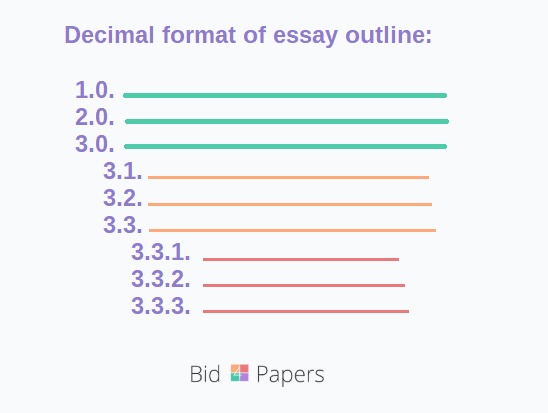
An alphanumeric outline is the most common one, but you are welcome to use a decimal outline structure if it seems clearer and more comfortable for you. Also, feel free to use complete sentences or just brief phrases for each section of your essay outline.
However, if you need to submit it to a professor for a review, use sentences. It will help him understand the arguments and evidence you are going to use in your essay.
Organize Your Outline
Now it’s time to fill in each section of your essay outline. For those lazy to read, here goes a short video:
For all others, start with outlining your introduction. Write a sentence about your topic and introduce your thesis. You can also mention an essay hook here – a sentence you’ll use to make the audience interested in reading your work.
Outline your essay body: write down a topic sentence for each paragraph, provide supporting evidence you’ll use when writing, and mention how they’ll relate to the topic and your thesis. The more details you outline, the easier it will be to organize all the thoughts while writing.
Also, you can write a transition sentence for each paragraph so it would be faster to structure and band all arguments.
Finally, outline your essay conclusion. Restate your thesis and write a concluding statement, aka a sentence addressing the importance of your thesis and proposing solutions to the problem you addressed in the essay.
It’s a Wrap!
Essays are many, and you need to write all of them in school and college. Persuasive, expository, narrative – their basic structure is the same but with tiny differences identifying their specifications and your knowledge of academic writing. Understanding those differences and outlining your writings accordingly is your chance to craft perfect works that get high grades.
An essay outline is what you need to organize the information and not miss anything while writing. When you know how to write an essay outline, you create papers better and faster. You keep in mind all essay components. You develop critical thinking. And you become a better writer.